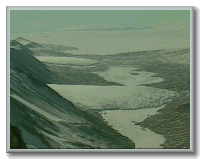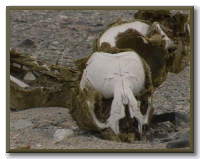LAKES AND SEALS OF THE McMURDO DRY VALLEYS REGION (NSF publication)
Lakes
Several large lakes occupy parts of some valley floors, their surfaces frozen much of the year. Some lakes are over 30 meters deep and have perennial ice covers several feet thick. Lake Vanda, which is typical, has 10 percent dissolved solids in its lowest few meters-three times as saline as sea water-while the upper 50 meters have only 0.1 percent. Scientists have noted high water temperatures in the lakes, with temperature inversions (warm water trapped below colder water) resulting in bottom waters as hot as 25 degrees C. These high temperatures are due entirely to solar heating of the water through the ice and not to any heat from rocks beneath the lakes. Explorations of lake bottoms by scuba-equipped limnologists (researchers who study rivers and lakes), including core sampling of bottom sediments, have disclosed the existence of algal life forms that are similar to those representing the earliest forms of life found on earth.
|

|

|
Mummified seals
The lower part of the Wright Valley, below Lake Vanda, is zoologically interesting. Scattered over several miles are mummified, rock-hard carcasses of Weddell seals. Radiocarbon dating of the remains is difficult, but scientists estimate that the carcasses are between 2,500 to 3,500 years old. Their travel inland so far from their coastal habitat is somewhat of a mystery.
|

![]()

